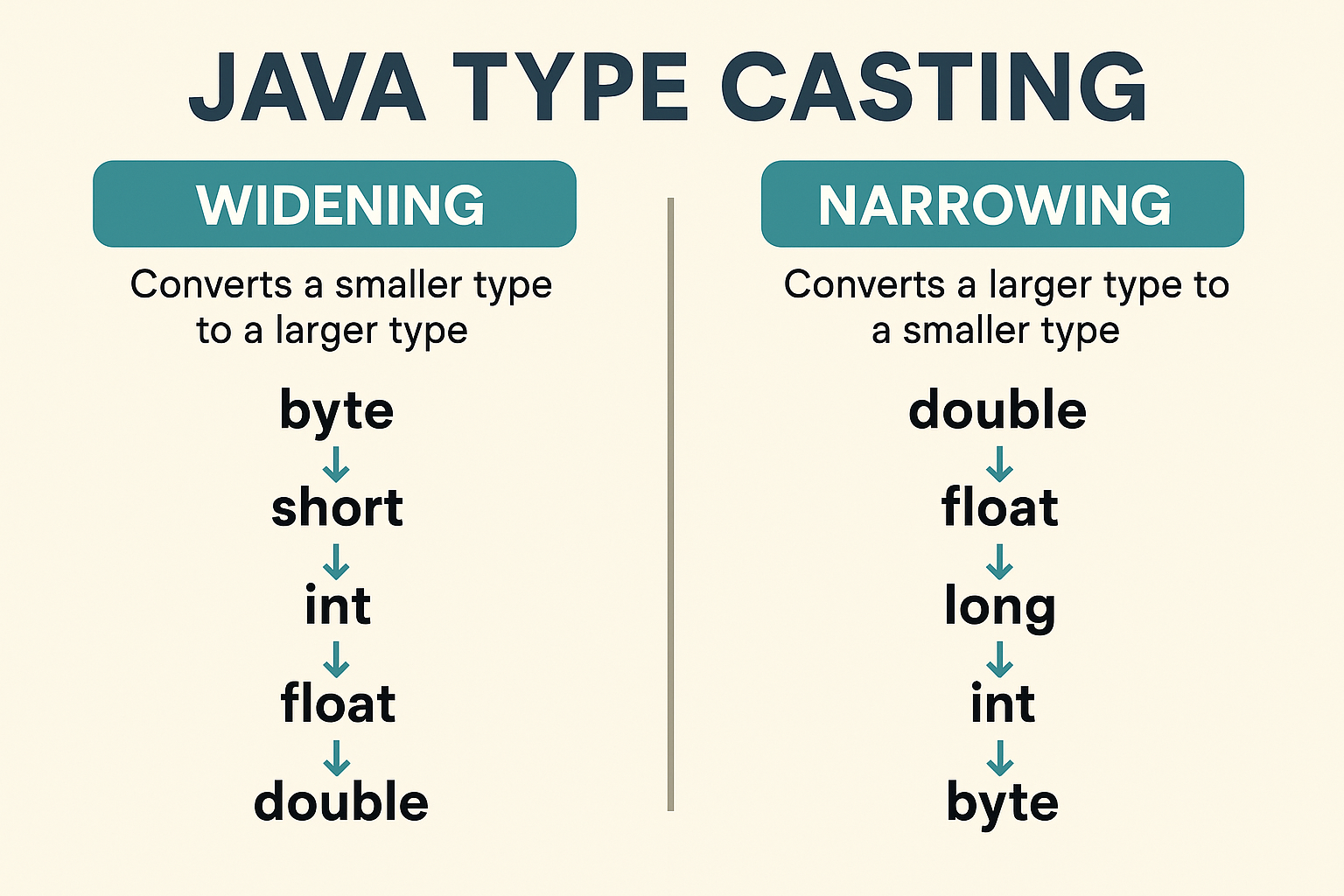Java Type Casting and Type Conversion – Widening vs Narrowing Conversion
Type casting and type conversion are essential concepts in Java for handling data types during variable assignments and arithmetic operations. They ensure compatibility between different data types while maintaining data integrity.
🔍 What is Type Conversion in Java?
Type conversion is the process of converting one data type into another. Java supports two main types of conversions:
- Widening (Implicit Conversion)
- Narrowing (Explicit Conversion)
🔄 Widening Conversion (Implicit Casting)
Also known as upcasting, widening conversion automatically converts a smaller data type into a larger one.
✅ Key Points:
- Performed automatically by the compiler.
- No data loss occurs.
- Compatible with numeric types.
Example:
public class WideningExample {
public static void main(String[] args) {
int num = 100;
double result = num; // int to double conversion
System.out.println(result); // Output: 100.0
}
}
📌 Supported Widening Conversions:
byte → short → int → long → float → double
char → int → long → float → double
🔽 Narrowing Conversion (Explicit Casting)
Also known as downcasting, narrowing conversion converts a larger data type into a smaller one.
✅ Key Points:
- Must be done manually using a cast operator
( ). - May cause data loss.
- Can result in overflow or precision loss.
Example:
public class NarrowingExample {
public static void main(String[] args) {
double value = 123.456;
int num = (int) value; // Explicit narrowing
System.out.println(num); // Output: 123
}
}
📌 When to Use:
- Working with legacy APIs.
- Memory optimization for large datasets.
- Converting floating-point to integers.
🆚 Widening vs Narrowing Conversion
| Feature | Widening Conversion | Narrowing Conversion |
|---|---|---|
| Type | Implicit (done automatically) | Explicit (manual casting) |
| Data Loss | No | Possible |
| Syntax | double d = intValue; |
int i = (int) doubleValue; |
| Performance Impact | Minimal | May require extra checks |
| Safety | Safe | May lead to runtime issues |
✅ Real-World Use Case
- Widening: Reading integer data from a file and storing as
doublefor calculations. - Narrowing: Storing large double values as int when only whole numbers are required.
🚫 Common Mistakes
- Forgetting explicit cast for narrowing:
double d = 9.8;
int i = d; // ❌ Compile-time error
- Ignoring data loss in narrowing:
int i = (int) 3.99; // Output: 3 (truncates decimal part)
💡 Tips & Best Practices
- Prefer widening where possible for safety.
- Avoid narrowing unless necessary.
- Use wrapper classes (
Integer,Double) for null-safe conversions.
🧠 Interview Relevance
-
Q: Is widening always safe?
-
A: Yes, no data loss occurs, but beware of floating-point precision differences.
-
Q: Can we convert
booleanto other types via casting? -
A: No,
booleanis not compatible with numeric types in Java.
🧩 Java Version Relevance
| Java Version | Feature |
|---|---|
| Java 1.0 | Widening and narrowing conversions introduced |
| Java 5+ | Autoboxing/unboxing improved type conversion handling |
✅ Summary
- Widening = Implicit, safe, no data loss.
- Narrowing = Explicit, potential data loss, manual casting required.
- Both are critical for handling type compatibility in Java applications.
